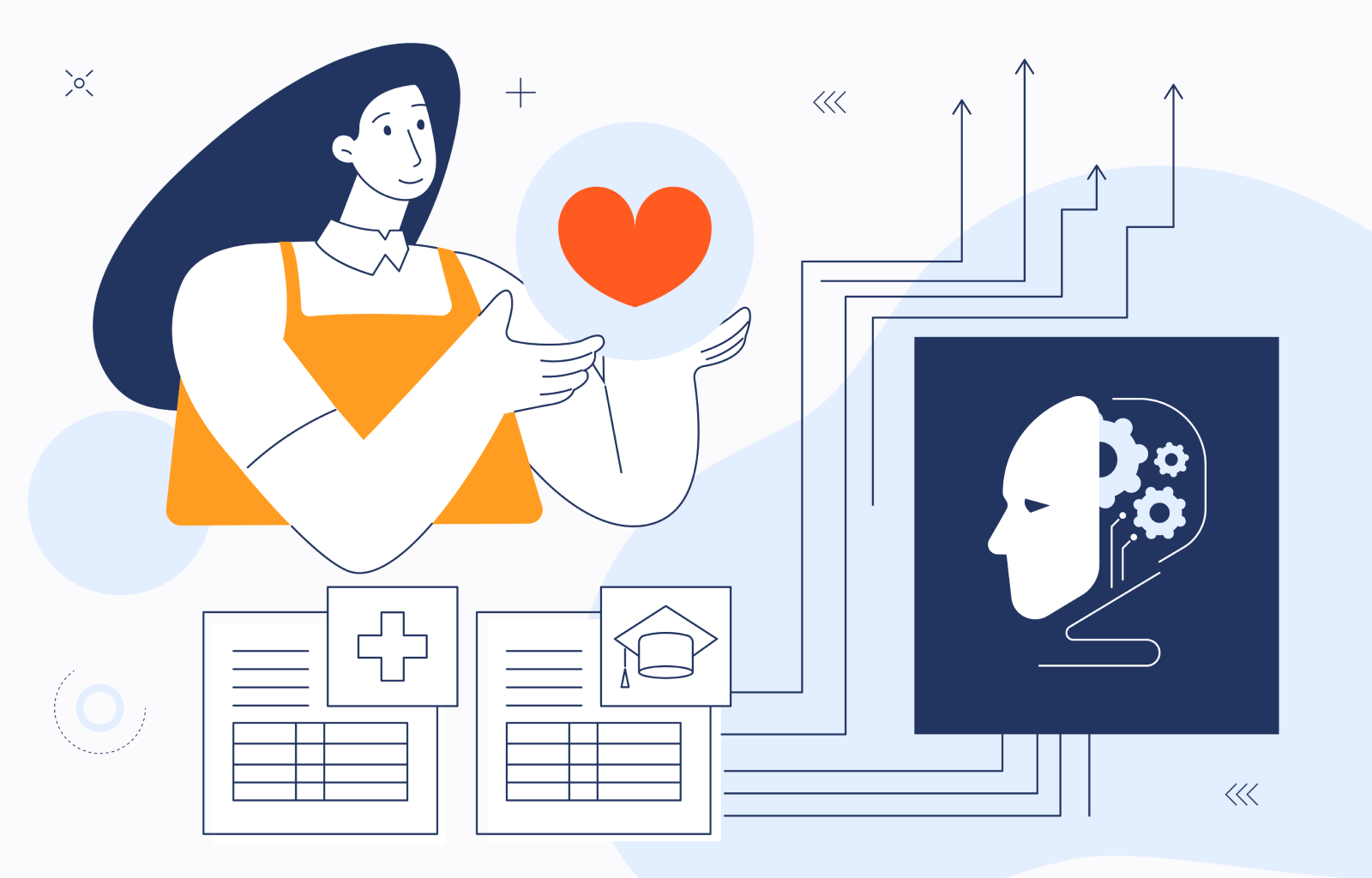Inside Medical Diagnostics AI: How Machine Learning Models Detect and Predict Diseases

Although some may see AI as a relatively new technology, it’s already widely used in medicine, with medical diagnostics AI being a major upgrade in accuracy. This is a crucial point in favor of using ML solutions, as combating even the most severe illnesses is easier when they’re detected at the outset.
AI helps doctors spot early signs of disease and get ahead of the problem. In this article, we’ll show the current applications of AI and ML for healthcare, talk about their training, and illustrate their utility with an example from our own practice.
What Is Medical Diagnostics AI
Machine learning in medicine has opened the door to complex models that enable doctors to use AI for diagnosis. This can mean compiling data to understand a particularly tricky case, predicting the potential onset of a disease, or analyzing signs to warn patients early. To accomplish this, AI specialists feed the algorithm with abundant data for it to analyze and visualize.
Training a diagnostic AI requires a substantial amount of data to ensure it is as accurate as possible. However, no matter how precise the tech becomes, the final diagnosis and expertise remain the doctor's responsibility. Even as doctors use artificial intelligence in their work, they put human knowledge first, treating an AI system simply as another tool in their arsenal.
Beyond just identifying what ails the patient, AI can be used in genomics to identify mutations in human DNA and highlight markers of specific diseases. It also allows doctors to make more personalized treatment plans, as a full understanding of a patient’s genome means knowing:
- Their allergies/sensitivities
- Predisposition to certain conditions
- Likelihood of conflicts with specific medications
How Machine Learning Models Learn to Detect and Predict Diseases
Most content on AI in healthcare focuses on its usability and potential applications. However, to truly understand AI and its applications, we need to take a more in-depth look. Let’s discuss how these models actually learn and what helps them detect signs of disease. We’ll take things step by step.
- The first stage is to collect data and “clean” it, meaning removing any data with errors in it or that doesn’t fit your chosen format. This is essential because it prevents AI disease detection from learning based on edge cases or incorporating incorrect information.
- Most of the time, data will come in massive sets that contain actual patient information, just anonymized for privacy’s sake. These sets include medical imaging (X-rays, CT, and MRI scans), lab tests, EHRs, and more. The size of the set is important because it helps AI “understand” the norm and what deviations from it look like.
- Usually, the sets are sourced from hospitals and clinics, processed by hired AI engineers who are part of their own medical staff or an AI development company. Having this stage of manual intervention to standardize and mark the data is essential as it speeds up processing and prevents errors in results.
- Versatile data provides the AI with a better understanding of each patient, supporting visual-based diagnostics. Each data set will have manually labeled cases for healthy and diseased patients. This expands the AI’s reference points and lets it compare the two to spot typical markers.
- As the AI “looks” at all this data, it will see even the tiniest deviations from the norm and changes in the patient’s state. This may include shifts in iron levels on bloodwork, subtle findings on scans, and new patient complaints. Using these, the AI cross-references its knowledge base to understand what the problem could be.
- Since accuracy is absolutely vital in the health and fitness industry, the model is then tested using all-new data, which it hasn’t had a chance to analyze before. This allows doctors to see whether the model can actually detect diseases based on subtle details.
Even once this process is done and the AI model is operational, it doesn’t stop learning. You should continuously provide it with extra sets and verify its precision with new cases. This not only guarantees that your AI diagnostics continues to work as intended but also helps refine it further.
Key Technologies Behind Medical Diagnostics AI
When we discuss the use of AI in diagnostics, it doesn’t mean just one piece of software or technology. In most cases, you’d be dealing with a complex system that incorporates any or all of the following:
- Neural networks
- Natural language processing (NLP)
- Predictive analytics
- Explainable AI
The first part, neural networks, is the tech you train to analyze images, including medical scans. We already explained how these play into diagnosing, using the AI’s “understanding” of these images to find discrepancies between healthy and diseased people.
Next, NLPs are tools used to interpret text, allowing AI to access information stored in doctors’ notes and medical histories. Using this, the system will learn the proper way to structure reports and analyze information on pre-existing conditions and previous treatment.
Predictive analytics is quite self-explanatory: it compiles all known data to predict the risk of certain diseases manifesting in a patient. The most prominent examples of predictive analytics healthcare can offer are anticipating diabetes and cancer. Both can be searched for based on behaviors and lifestyle markers.
Lastly, explainable AI in healthcare is used to dissect the analytical process and show doctors how the system arrived at certain conclusions. This is important because it creates accountability: AI cannot simply state its verdict without justification. Having explainable AI is crucial for onboarding and adoption, too, as it allows people to familiarize themselves with its inner workings.
Accuracy, Safety, and Trust
We’ve mentioned it above, but accuracy is the cornerstone of using diagnostic AI. Validating the output your system gives you and testing it for errors are your protections against misdiagnosis. Moreover, remember that uniform data from hospitals may be biased, whether by gender or against certain conditions that are rare in some regions.
Plus, remember that regulators like the FDA and Health Canada have total control over your ability to use AI, and their requirements must be followed diligently. Sometimes this means properly anonymizing data; other times, it simply means leaving the final decision to the doctor. The latter is just good practice, letting human experience trump the system’s opinion.
How Medical Clinics Can Solve the Problem of Insufficient Real Data for Training Models
Some clinics may struggle to source the necessary data sets to train their models. Luckily, the solution exists, and it’s synthetic data. This type of information is created using genAI or via statistical modeling, following the structure of real sets. Another option is the use of realistic simulations, which enable more controlled data generation and mirror real-life clinical processes.
In addition to addressing the need for data sets, synthetic data can be a good choice because it provides fully anonymized, privacy-compliant data and may cost less to source than a real dataset would. Plus, unlike hospital sets, synthetic data can have no bias based on gender or race, unlike actual sets.
AIf you want to deeply understand the whole process of working with synthetic data, Eugene Makieiev has already described the right approaches and all the options for you.
Integrio Case of Working with Medical Diagnostics AI
All of the above is based on Integrio Systems’ own experience with machine learning in personalized medicine. One of the more prominent cases related to this in our portfolio is Synnovis. This pathology provider works directly with the UK’s NHS system, providing lab tests to millions of patients. Processing that volume of analytics and results was proving challenging, so Synnovis turned to us to integrate AI into their ecosystem.
The primary objectives were straightforward: identifying duplicate requests, eliminating errors, enabling predictive analytics for disease detection, and enhancing decision-making. Our team got to work, building AI capabilities into the Synnovis system and analyzing all of their data. Based on these sets, we developed a model that forecasts patient needs using clinical trends.
We also added a focus on early prediction for specific high-risk conditions, such as diabetes, using both symptomatic signs and indicative test results. As a result, Synnovis could not only process testing and its results faster, but also offer a more in-depth analysis of patient states. The company’s clinicians now had to work less while achieving more.
So if you want to incorporate diagnostic AI in your healthcare business, there’s no better partner than Integrio Systems. Reach out today, and we’ll consult on the best way to implement AI in your operations.
Contact us

